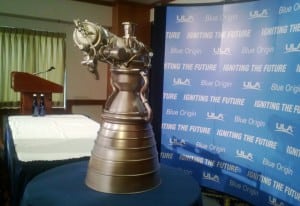Latest News
[Via Satellite 09-18-2014] United Launch Alliance (ULA) has selected Jeff Bezos’ aerospace company Blue Origin to build the Blue Engine 4 (BE-4) to replace the Russian-built RD-180, which is currently used to power ULA’s Atlas 5 launch vehicle. The decision follows news from earlier this summer that that ULA had signed multiple contracts to evaluate domestically produced next generation engine designs.
Speaking at the National Press Club in Washington, D.C., Blue Origin Founder Jeff Bezos and ULA President and CEO Tory Bruno, unveiled a scale model of the BE-4; the final version will measure 12 feet in height. The engine is the largest ever built by Blue Origin, delivering 550,000 lbs of thrust through the use of liquid oxygen and liquefied natural gas. ULA intends to use two BE-4 engines in lieu of the kerosene-fueled RD-180, which will ultimately result in a more powerful launch vehicle, delivering 1.1 million pounds of thrust.
Bruno said the BE-4 is not a “one-for-one” replacement for the RD-180, but that ULA will attempt to integrate the engines into the baseline Atlas vehicle. He declined to comment on the extended impact replacing the RD-180 will have on the Atlas 5, but admitted it may result in larger changes to the company’s rocket families.
“We are currently in the middle of our studies on exactly what the vehicle configuration will be that uses this new propulsion technology,” said Bruno.
The Boeing–Lockheed Martin joint venture’s search for a new engine was prompted by increased political tension between the United States and Russia following the latter’s annexation of Crimea. A U.S. court temporarily banned the purchase of the RD-180, which is manufactured by NPO Energomash and sold to ULA through RD Amross. Around the same time, Russian Deputy Prime Minister Dmitry Rogozin made statements that suggested Russia might terminate the engine sales altogether if they continued to assist U.S. national security missions.
Congress previously debated allocating $220 million in funding for a domestically produced engine, which was estimated would take eight years to build at a cost of roughly $2 billion. Thanks to ULA’s partnership with Blue Origin, a functioning replacement is expected by 2019 after the completion of a seven-year development process. Bezos said Blue Origin has been working on the BE-4 for three years, allowing ULA to accelerate an otherwise unchangeable development schedule.
Together, the companies plan to start full scale testing in 2016. Blue Origin recently began testing the BE-4 engine at a facility in West Texas designed to withstand more than a million pounds of thrust — a site that took three years to build. Bezos said the company has been testing subscale injectors and conducting injector element tests and will soon begin additional evaluations.
Bezos and Bruno declined to reveal the amount ULA is paying for the new engine. The goal, according to Bezos, is to make the engine “as simple as it can be” in order to keep costs low. Bruno said the BE-4 would certainly be more cost effective than the RD-180, which previously attracted congressional attention over the amount charged by RD Amross.
“Our goal is to make the engine so operable, so low cost and so reliable, that ULA would be crazy use anything else,” said Bezos.
Bezos said the BE-4 will power a Blue Origin launch vehicle in the future. Currently, the company is working on a reusable suborbital launch vehicle named New Shepard, which uses the smaller BE-3 engine. Likewise, the Blue Origin-Boeing XS-1 spaceplane will use the BE-3. Bezos said this engine has more than 10,000 seconds of test time and hundreds of starts with a failure rate of less than 2 percent during the development process.
Blue Origin and ULA are also considering other joint projects that were not disclosed. Bruno said the partnership has no bearing on the Air Force’s block buy for the Evolved Expendable Launch Vehicle (EELV) program, and did not influence the Commercial Crew Transportation Capability (CCtCap) bid for which Boeing’s CST-100 capsule would fly atop the Atlas 5. Both the crewed missions and the contracted block buy launches were won with the RD-180 and will launch with the Russian engine unless NASA or the Air Force decide otherwise.
Get the latest Via Satellite news!
Subscribe Now